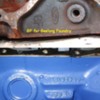quote:
Originally posted by AJThree:
The block also has 0L5G stamped into the front of the block just to the left of the water pump. Any idea what this number is?
My block has this also. It is a D2-CA block.
I don't know for sure BUT my Australian friends tell me that blocks manufactured in Australia are REQUIRED by Australian law to have a "serial number" stamped in this area.
Australian vehicles with 351c's have thier VIN number stamped there.
Wow, I wonder if your engine and my engine both came from the same car? Do you think?
I also know that the mint mark, so to speak, for the Australian casting is G.
YEA, YEA, EVERYBODY STOP YELLING AND QUITE DOWN NOW!
My Australian friends also claim that ALL 351c blocks with the ID D2..-CA were cast in Australia and are "high nickle" Australian blocks. HEY! I TOLD YOU GUYS TO QUITE DOWN AND STOP YELLING!
I didn't say NASCAR XE blocks now did I?
There was some talk about doing a Rockwell hardness test on the blocks but it hasn't quite develped yet.
I also seem to remember something about the "legal" blocks for the '72 Pro stock series vaugly. Very vaugly...and they weren't the XE blocks. Those weren't legal for PROSTOCK.
BARKEEP! 'nother round!


